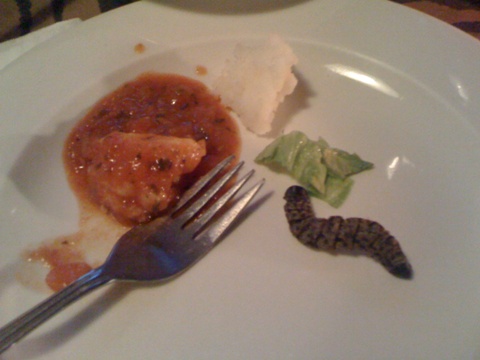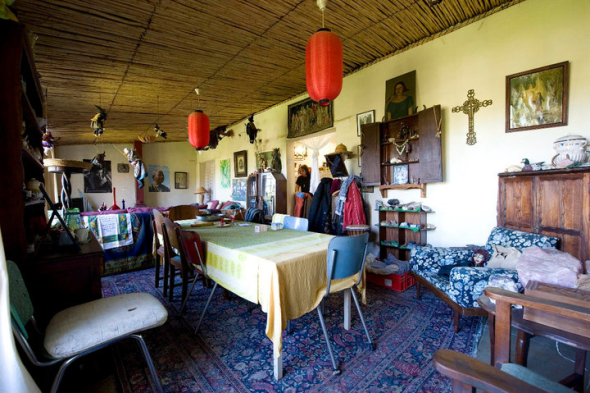
We tend to think of insects as invasive wildlife. We consider them health hazards, destructive pests, and nasty little critters that breed and do their private business in and on our food. Grub might mean food, but bug is a synonym for germs and synonymous with irritating behaviour or computer glitches. We spray, swat, and stomp on them. Many insects think we’re something to eat. We seldom bite back.
That may change. Actually we all eat insects without any harmful side effects; roughly 500g of creepy-crawly per annum. Unless you’re on Fear Factor or a similarly distasteful reality television show, if you live in the West you partake of bug unknowingly. Apart from the urban myth that we eat spiders in our sleep, scrunched up beasties find their way into processed foods such as tomato sauce, peanut butter and chocolates. There are regulatory tables limiting how much and what kind of arthropod is allowed in your food. 20 maggots per 100g of canned mushrooms is acceptable. When new US food labelling rules come into force in January, we may all be surprised by how many of the beverages and foods we consume contain the red dye from ground-up cochineal scale insects.
Most of humanity however eats insects as a matter of course. I first found this out backpacking through South-East Asia. In markets there, baskets overflowed with fried cricket, locust and even praying mantis. Termite flour is common in Nigeria, as are termite stock cubes; in Uganda, termites are lured to the pot by special drumming techniques, and palm grubs are sautéed in their own oil; there are sago grub festivals in New Guinea and Nigeria; in Algeria, locusts are cooked in salt water and dried. The variety is great, with flavours from peppery and nutty to salty and buttery, from charcoal roasted dragonfly in Bali to huhu beetle grubs in New Zealand.
And why not? We’ve watched David Attenborough eat live honeypot ants on camera. Heston Blumenthal, the celebrity television chef, sampled mealworms and canned silkworm pupae, before serving his A-list guests deep-fried crickets and tomato-filled grubs.
Some researchers estimate insects destroy 25% of world food production. As global population burgeons exponentially, the tables will have to be turned.
In a paper delivered at the Royal Entomology Society conference at Swansea University earlier this year, Professor Arnold van Huis of Wageningen University in Belgium (no reflection on his national cuisine) proposed insect protein as the most realistic solution to world nutrition.
The argument for entomophagy is compelling; rationally, there is no reason not to. We have run out of cultivatable land. To produce a kilogram of cricket meat requires less than 15% of the input needed to produce the equivalent amount of beef, a fraction of the cost and far less carbon emissions. Insect farming, even on a large scale, carries fewer health risks than conventional industrial agriculture. You’re not going to get mad beetle disease any time soon. Insect meat is high in protein, low in fat, and rich in B vitamins, iron and calcium. There are almost 1500 species of edible insect.
To boot, they’re kosher. Leviticus 11:21-22: “you may eat those that have jointed legs for hopping on the ground. Of these you may eat any kind of locust, katydid, cricket or grasshopper”. The Pentateuch however forbids eating sea goggas: “Anything living in the water that does not have fins and scales is to be detestable to you.” Were prawns land-based creatures (as some believe they are in Parktown), there’d be a lot of jumping on chairs and screaming.
Vincent Holt in a rather delicious little tract, Why Not Eat Insects? (1885), hoped he’d found the solution to malnutrition amongst the working classes. His menus read like a Monty Python sketch: slug soup, stag beetle larvae on toast, new carrots with wireworm sauce, caterpillar garnish, and curried cockchafers (no kidding).
In the downstairs food hall of Fortnum and Masons, London, I found translucent amber toffee containing a real edible scorpion, giant Japanese hornet in a bottle of clear honey, oven-baked whole Cambodian tarantula, and vacuum- packed, salted Mopani worms.
Like many Westerners, I’m irrational when it comes to eating grubs. The only caterpillar I’d ever chomped was in Mexico; the maguey worm at the bottom of a bottle of mescal, and only after I’d finished the mescal.
In South Africa, the vivid-coloured larvae of the Emperor Moth feed on Limpopo’s attractive Mopani trees, hence their common name. Mopani is now a multi-million rand industry. Harvesters extrude the green guts from a worm (Imbrassia belina, known as Masonja in North Sotho) as if milking a teat. The bigger the caterpillar, the better; young worms have less taste. The Mopani worms are boiled in salted water for 30 minutes, before they are dried in the sun by turning them every hour or so. This can take all day.
Not uncommon in Johannesburg, Mopani worms seem to have disappeared from the menus of most of Cape Town’s African restaurants such as the Africa Cafe and Mama Africa. One of the few places serving them is Marco’s African Place. Mopani worms (R85) on a bed of salad take about 25 minutes to prepare. They are salty and chewy, and they are quite heavy on the stomach; the word ‘delicacy’ didn’t spring to mind.
Thongolifha, an edible stink-bug (Encosternum delegorguei), considered a pest by some farmers, is a delicacy among the Venda, and in parts of Zimbabwe. The live bugs have to be provoked with hot water and repeatedly rinsed until they are void of their extremely pungent defensive pheromones. Protein-rich thongolifha are boiled live and dried.
The past decade has produced numerous insect cookbooks. If you’re bitten by this bug, you might put away the Doom and reach for the Spray and Cook.
Marco’s African Place, 15 Rose Lane, Cape Town. Tel: 021 423 5412.

